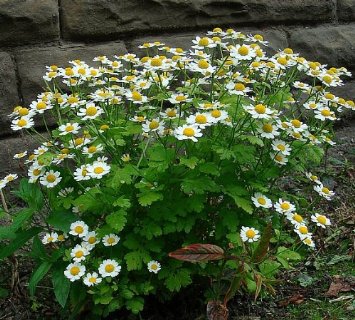Growing Feverfew
Why is growing feverfew a valuable addition to your garden? This lovely plant has earned its name for its ability to ease fever and its tonic affect on the immune system. Better still, it's easy to grow. Once you get it started, it's a low-maintenance plant and well worth the growing space.
Not only has this perennial been popular for years to reduce the ill effects of fever, recent studies have also shown it as highly effective in preventing and easing the symptoms of migraines.
So be sure to reserve a space in your self-reliant garden for some feverfew. You'll be glad you did. Here are eight reasons you should be growing feverfew in your homestead garden.

1. It Eases Fever
Just as its name says, drinking an infusion of feverfew will help ease the discomfort of fever.
By the way, making an infusion is exactly the same as making a cup of tea. Place about a teaspoon of the dried herb in a cup and cover it with hot water. Allow it to steep for at least ten minutes and sweeten it with honey.
2. It Eases Nervousness
Are you feeling edgy? Make and drink an infusion of feverfew to help ease nerves.
3. Great For Tummy Troubles
Feverfew works like a laxative to ease constipation. Are you suffering from flatulence? Drinking a feverfew infusion will help with that as well, along with easing gas pains.
Feverfew will also ease symptoms of nausea and vomiting as well as stimulate the appetite.
4. It Helps With Menstrual Troubles
Drinking an infusion of feverfew will stimulate blood flow, especially to the pelvic area and uterus and has been used to stimulate menstruation, which is exactly why you should not drink feverfew if you are pregnant.
But in all other cases it is fine and will also help to ease menstrual cramps.
5. It Can Be Used For Pain
Feverfew is a mild analgesic and can relieve both headaches and earaches.
6. Useful For Easing Coughs
Drinking a feverfew infusion will also help ease a cough, as well as help with wheezing and difficult breathing.
7. A Natural Insect Repellent
Make a feverfew tincture by filling a small glass jar with enough fresh feverfew to fill it completely. Cover it with vodka, and then take a butter knife and gently stir around the edges of the jar to clear out any glass bubbles. Close the jar with a lid and store it in a cool, dark place for about three weeks, shaking it twice a day.
Mix two teaspoonsful of this feverfew tincture with 1/2 pint of cold water to make a natural insect repellent.
8. Ease the Pain of Insect Bites
The tincture doesn't just keep insects away, but is also healing. Apply your tincture to insect bites to relieve pain and swelling.
Tips on Growing Feverfew
The herb Feverfew will grow in any type of soil but prefers good drainage.
It is a low-maintenance plant once it gets growing.
Sow seeds directly into the soil in the spring and then thin to 2 to 3 inches apart.
Weed by hand, as the plants could be injured by hoeing. When harvesting feverfew, use the bark, dried flowers, and leaves.
A Word of Caution...
I've already mentioned this, but I'm saying it again: Do not take Feverfew if you are pregnant as it may cause a miscarriage.
Also, people were once encouraged to chew the leaves of Feverfew to ease symptoms, but doing so could cause mouth sores. So just make an infusion instead.
Learn More About Medicinal Herbs








New! Comments
Have your say about what you just read! Leave me a comment in the box below.